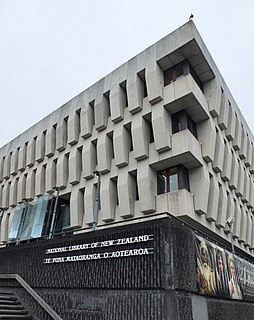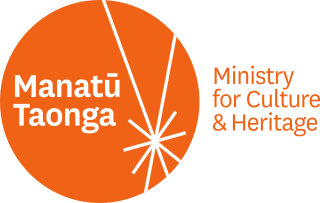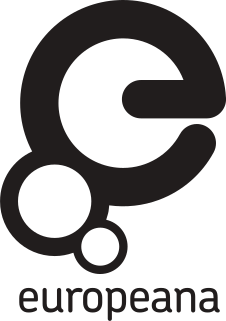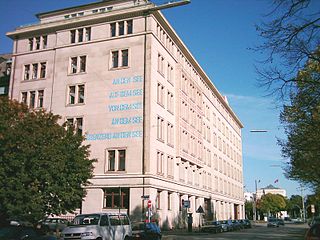Related Research Articles
A web portal is a specially designed website that brings information from diverse sources, like emails, online forums and search engines, together in a uniform way. Usually, each information source gets its dedicated area on the page for displaying information ; often, the user can configure which ones to display. Variants of portals include mashups and intranet "dashboards" for executives and managers. The extent to which content is displayed in a "uniform way" may depend on the intended user and the intended purpose, as well as the diversity of the content. Very often design emphasis is on a certain "metaphor" for configuring and customizing the presentation of the content and the chosen implementation framework or code libraries. In addition, the role of the user in an organization may determine which content can be added to the portal or deleted from the portal configuration.

The National Library of New Zealand is New Zealand's legal deposit library charged with the obligation to "enrich the cultural and economic life of New Zealand and its interchanges with other nations". Under the Act, the library's duties include collection, preserving and protecting the collections of the National Library, significant history documents, and collaborating with other libraries in New Zealand and abroad.

The New Zealand Film Commission is a New Zealand government agency formed to assist with creating and promoting New Zealand films. It was established under the New Zealand Film Commission Act 1978.
A mashup, in web development, is a web page or web application that uses content from more than one source to create a single new service displayed in a single graphical interface. For example, a user could combine the addresses and photographs of their library branches with a Google map to create a map mashup. The term implies easy, fast integration, frequently using open application programming interfaces and data sources to produce enriched results that were not necessarily the original reason for producing the raw source data. The term mashup originally comes from creating something by combining elements from two or more sources.

The New Zealand Electronic Text Collection is a freely accessible online archive of New Zealand and Pacific Islands texts and heritage materials that are held by the Victoria University of Wellington Library. It was named the New Zealand Electronic Text Centre until October 2012.

Ngā Taonga Sound & Vision is an archive that was launched on 31 July 2014, following the completion of a three-year process whereby the New Zealand Film Archive "absorbed" the collections and operations of the RNZ Sound Archives Ngā Taonga Kōrero in 2012 and the Television New Zealand Archive in 2014.
Nuxeo is a software company making an open source content management system.

The Ministry for Culture and Heritage is the department of the New Zealand Government responsible for supporting the arts, culture, built heritage, sport and recreation, and broadcasting sectors in New Zealand and advising government on such.

Europeana is a web portal created by the European Union containing digitised cultural heritage collections of more than 3,000 institutions across Europe. It includes records of over 50 million cultural and scientific artefacts, brought together on a single platform and presented in a variety of ways relevant to modern users. The prototype for Europeana was the European Digital Library Network (EDLnet), launched in 2008.

The National Library of Economics is the world's largest research infrastructure for economic literature, online as well as offline. The ZBW is a member of the Leibniz Association and has been a foundation under public law since 2007. Several times the ZBW received the international LIBER Award for its innovative work in librarianship. The ZBW allows for access of millions of documents and research on economics, partnering with over 40 research institutions to create a connective Open Access portal and social web of research. Through its EconStor and EconBiz, researchers and students have accessed millions of datasets and thousands of articles. The ZBW also edits two journals: Wirtschaftsdienst and Intereconomics.

Trove is an Australian online library database aggregator and service which includes full text documents, digital images, bibliographic and holdings data of items which are not available digitally, and a free faceted-search engine as a discovery tool. The database includes archives, images, newspapers, official documents, archived websites, manuscripts and other types of data. Hosted by the National Library of Australia in partnership with content providers, including members of the National and State Libraries Australia, it is one of the most well-respected and accessed GLAM services in Australia, with over 70,000 daily users.

An application programming interface (API) is a way for two or more computer programs to communicate with each other. It is a type of software interface, offering a service to other pieces of software.A document or standard that describes how to build or use such a connection or interface is called an API specification. A computer system that meets this standard is said to implement or expose an API. The term API may refer either to the specification or to the implementation.
The JISC Digitisation Programme was a series of projects to digitise the cultural heritage and scholarly materials in universities, libraries, museums, archives, and other cultural memory organizations in the United Kingdom, from 2004 to 2010 The program was managed by the UK's Joint Information Systems Committee, the body that supports United Kingdom post-16 and higher education and research in support of learning, teaching, research and administration in the context of ICT.

Dryad is an international open-access repository of research data, especially data underlying scientific and medical publications. Dryad is a curated general-purpose repository that makes data discoverable, freely reusable, and citable. The scientific, educational, and charitable mission of Dryad is to provide the infrastructure for and promote the re-use of scholarly research data.
The UC CEISMIC Canterbury Earthquakes Digital Archive programme was established in 2011 with the aim of preserving the knowledge, memories and earthquake experiences of people of the Canterbury region. The website provides federated access to a broad range of earthquake-related research material, gathered by leading New Zealand cultural and educational organisations.

Samvera, originally known as Hydra, is an open-source digital repository software product. Samvera main components are Fedora Commons, Solr, Blacklight, and HydraHead. Each Samvera implementation is called a "head".
The Television New Zealand Archive collection contains over 600,000 hours of television spanning almost 55 years of New Zealand's public television history. It includes iconic New Zealand content such as documentaries, dramas, sports programmes and every TVNZ news broadcast from December 1986 to 2014. The archive only holds titles that have previously been broadcast – raw footage is not included. The archive also includes thousands of photographic stills. Both TVNZ and the Ministry for Culture and Heritage hold a list of the titles held in the TVNZ Archive collection. This has subsequently been released under the Official Information Act. The Ministry considers the majority of titles to be of high heritage and cultural value and the Minister of Broadcasting Craig Foss stated it was a "unique record of life in New Zealand". The contents of the collection are subject to the Public Records Act 2005. In 2014 the Ministry for Culture and Heritage, on behalf of the Crown, became the guardian of the archive. The physical collection is located in the Wellington region, in the former TVNZ Avalon facility now owned by the Department of Internal Affairs.
The National Documentation Centre of Greece is a public organisation that promotes knowledge, research, innovation and digital transformation. It was established in 1980 with funding from the United Nations Development Programme with the aim to strengthen the collection and distribution of research-related material, and to ensure full accessibility to it. It has been designated as a National Scientific Infrastructure, a National Authority of the Hellenic Statistical System, and National Contact Point for European Research and Innovation Programmes. Since August 2019, it has been established as a discrete public-interest legal entity under private law, and is supervised by the Ministry of Digital Governance. The management bodies of EKT are the Administrative Board and the Director who, since 2013, has been Dr. Evi Sachini.

Te Awahou Nieuwe Stroom is a multi-cultural, multi-purpose visitor and community hub in Foxton, in the southern part of New Zealand's North Island. The facility hosts some 150,000 users annually - to visit the Maori and Dutch museums, the library or the community rooms, the gallery or the heritage room. Locals take care of their affairs in the Council Service Centre.
References
- ↑ "Media release: Digital New Zealand Launched". National Library of New Zealand website. National Library of New Zealand. 3 December 2008. Retrieved 10 November 2011.
- 1 2 Johnston, Courtney (14 November 2008). "First Digital New Zealand products go live". National Library of New Zealand. Archived from the original on 17 May 2017. Retrieved 20 November 2022.
- 1 2 "About DigitalNZ". DigitalNZ. National Library of New Zealand. Retrieved 8 May 2020.
- ↑ 2011 - Supreme Mashup: A Grand Mother by Candy Elsmore 2011 - Supreme Data Mashup: 100 Companies by Alex Gibson & Graham Jenson 2010 - Supreme Remix: An Opal Dream Cave by Jem Yoshioka 2010 - Supreme Mashup: NZ Walks information by Daniel Pietsch
- ↑ "Make it Digital". DigitalNZ. Retrieved 8 May 2020.
- ↑ "DigitalNZ ā-tihi o Aotearoa: Connecting the Digital Content of New Zealand: Advice, Open Standards and Interoperability". DCMI International Conference on Dublin Core and Metadata Applications = 2009.
- ↑ CONZUL Working Group (1 July 2016). Universities New Zealand Te Pōkai Tara Research Data Management Feasibility Study Report (PDF) (Report). Universities New Zealand. Retrieved 31 May 2019.
- ↑ "DigitalNZ - Making it easy to find New Zealand's digital treasures". data.govt.nz. June 2015. Retrieved 31 May 2019.
- ↑ "Supplejack : Licence". digitalnz.github.io. Retrieved 31 May 2019.
- 1 2 Susan Bouterey; Lawrence E. Marceau (14 August 2018). "Chapter 10 The Challenges, the Project, and the Politics: Lessons from Six Years of the UC CEISMIC Canterbury Earthquakes Digital Archive". Crisis and Disaster in Japan and New Zealand: Actors, Victims and Ramifications. Springer. ISBN 9789811302442.
- ↑ "Supplejack : About". digitalnz.github.io. Retrieved 31 May 2019.
- ↑ "NZOSA Awards 2016". nzosa.org.nz. New Zealand Open Source Awards. Retrieved 31 May 2019.
- ↑ "DIGITALNZ Wins at the NZ Open Source Awards". digitalnz.org. Retrieved 31 May 2019.
- ↑ "Singapore adopts NZ search service". natlib.govt.nz. 27 March 2014. Retrieved 31 May 2019.
- ↑ Ngā Taonga Annual Report 2015/16 (PDF) (Report). Ngā Taonga Sound & Vision. Retrieved 31 May 2019.
- ↑ "Digital collection aggregation with Supplejack". boost.co.nz. Retrieved 12 July 2021.
- ↑ Barry, Matthew; Sifton, Daniel. Towards a Cross-Canadian Digital Library Platform (PDF) (Report). Retrieved 31 May 2019.
- ↑ "International appetite for Supplejack metadata aggregator". boost.co.nz. Retrieved 31 May 2019.